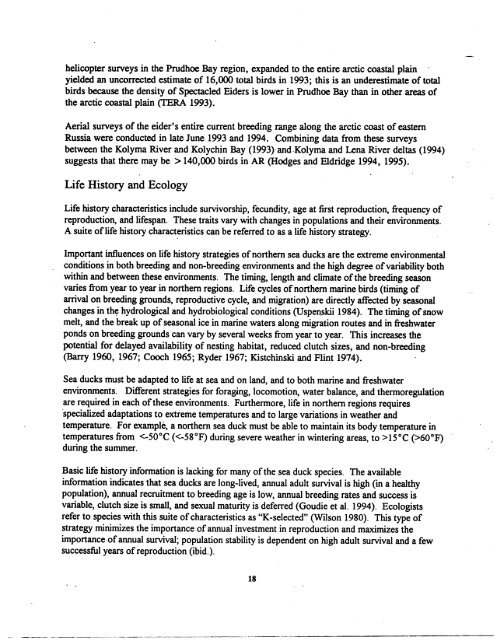A. Status of the Spectacled Eider - U.S. Fish and Wildlife Service
A. Status of the Spectacled Eider - U.S. Fish and Wildlife Service
A. Status of the Spectacled Eider - U.S. Fish and Wildlife Service
Create successful ePaper yourself
Turn your PDF publications into a flip-book with our unique Google optimized e-Paper software.
helicopter surveys in <strong>the</strong> Prudhoe Bay region, exp<strong>and</strong>ed to <strong>the</strong> entire arctic coastal plain<br />
yielded an uncorrected estimate <strong>of</strong> 16,000 total birds in 1993; this is an underestimate <strong>of</strong> total<br />
birds because <strong>the</strong> density <strong>of</strong> <strong>Spectacled</strong> <strong>Eider</strong>s is lower in Prudhoe Bay than in o<strong>the</strong>r areas <strong>of</strong><br />
<strong>the</strong> arctic coastal plain (TERA 1993).<br />
Aerial surveys <strong>of</strong> <strong>the</strong> eider’s entire current breeding range along <strong>the</strong> arctic coast <strong>of</strong> eastern<br />
Russia were conducted in late June 1993 <strong>and</strong> 1994. Combining data from <strong>the</strong>se surveys<br />
between <strong>the</strong> Kolyma River <strong>and</strong> Kolychin Bay (1993)<strong>and</strong>-Kolyma <strong>and</strong> Lena River deltas (1994)<br />
suggests that <strong>the</strong>re may be > 140,000 birds in AR (Hodges <strong>and</strong> Eldridge 1994, 1995).<br />
Life History <strong>and</strong> Ecology<br />
Life history characteristics include survivorship, fecundity, age at first reproduction, frequency <strong>of</strong><br />
reproduction, <strong>and</strong> lifespan. These traits vary with changes in populations <strong>and</strong> <strong>the</strong>ir environments.<br />
A suite <strong>of</strong>life history characteristics can be referred to as a life history strategy.<br />
Important influences on life history strategies <strong>of</strong> nor<strong>the</strong>rn sea ducks are <strong>the</strong> extreme environmental<br />
conditions in both breeding <strong>and</strong> non-breeding environments <strong>and</strong> <strong>the</strong> high degree <strong>of</strong>variability both<br />
within <strong>and</strong> between <strong>the</strong>se environments. The timing, length <strong>and</strong> climate <strong>of</strong><strong>the</strong> breeding season<br />
varies from year to year in nor<strong>the</strong>rn regions. Life cycles <strong>of</strong>nor<strong>the</strong>rn marine birds (timing <strong>of</strong><br />
arrival on breeding grounds, reproductive cycle, <strong>and</strong> migration) are directly affected by seasonal<br />
changes in <strong>the</strong> hydrological <strong>and</strong> hydrobiological conditions (Uspenskii 1984). The timing <strong>of</strong>snow<br />
melt, <strong>and</strong> <strong>the</strong> break up <strong>of</strong>seasonal ice in marine waters along migration routes <strong>and</strong> in freshwater<br />
ponds on breeding grounds can vary by several weeks from year to year. This increases <strong>the</strong><br />
potential for delayed availability <strong>of</strong> nesting habitat, reduced clutch sizes, <strong>and</strong> non-breeding<br />
(Barry 1960, 1967; Cooch 1965; Ryder 1967; Kistchinski <strong>and</strong> Flint 1974).<br />
Sea ducks must be adapted to life at sea <strong>and</strong> on l<strong>and</strong>, <strong>and</strong> to both marine <strong>and</strong> freshwater<br />
environments. Different strategies for foraging, locomotion, water balance, <strong>and</strong> <strong>the</strong>rmoregulation<br />
are required in each <strong>of</strong><strong>the</strong>se environments. Fur<strong>the</strong>rmore, life in nor<strong>the</strong>rn regions requires<br />
specialized adaptations to extreme temperatures <strong>and</strong> to large variations in wea<strong>the</strong>r <strong>and</strong><br />
temperature. For example, a nor<strong>the</strong>rn sea duck must be able to maintain its body temperature in<br />
temperatures from 600F)<br />
during <strong>the</strong> summer.<br />
Basic life history information is lacking for many <strong>of</strong><strong>the</strong> sea duck species. The available<br />
information indicates that sea ducks are long-lived, annual adult survival is high (in a healthy<br />
population), annual recruitment to breeding age is low, annual breeding rates <strong>and</strong> success is<br />
variable, clutch size is small, <strong>and</strong> sexual maturity is deferred (Goudie et al. 1994). Ecologists<br />
refer to species with this suite <strong>of</strong>characteristics as “K-selected” (Wilson 1980). This type <strong>of</strong><br />
strategy minimizes <strong>the</strong> importance <strong>of</strong>annual investment in reproduction <strong>and</strong> maximizes <strong>the</strong><br />
importance <strong>of</strong>annual survival; population stability is dependent on high adult survival <strong>and</strong> a few<br />
successful years <strong>of</strong> reproduction (ibid.).<br />
18

















